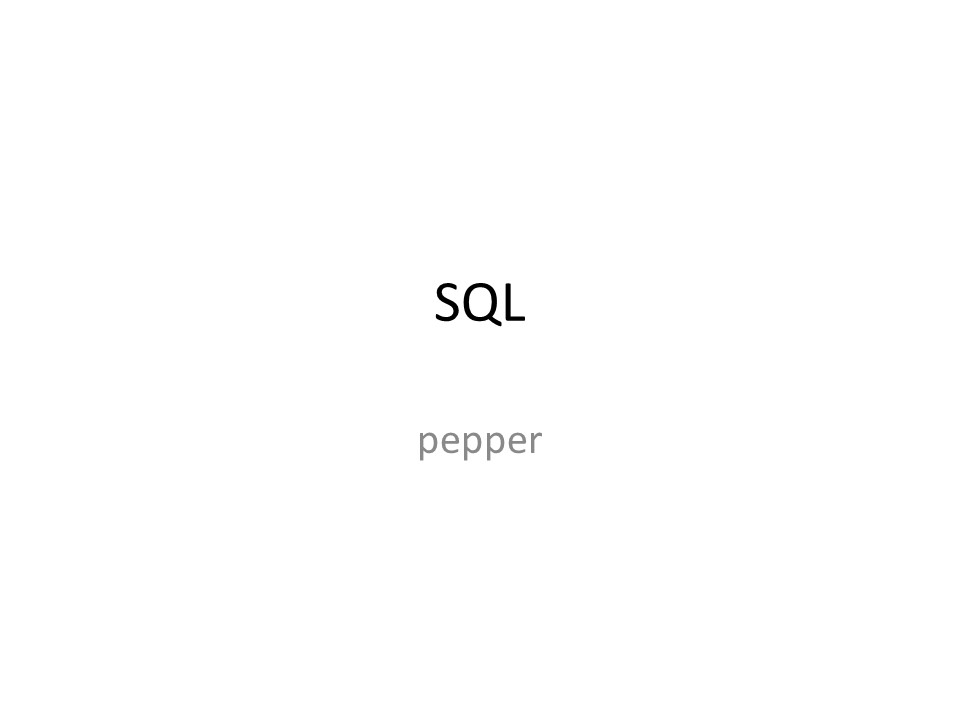SQL - PowerPoint PPT Presentation
Title:
SQL
Description:
SQL pepper Why SQL File I/O is a great deal of code Optimal file organization and indexing is critical and a great deal of code and theory implementation File locking ... – PowerPoint PPT presentation
Number of Views:94
Avg rating:3.0/5.0
Title: SQL
1
SQL
- pepper
2
Why SQL
- File I/O is a great deal of code
- Optimal file organization and indexing is
critical and a great deal of code and theory
implementation - File locking
- Security concerns
- Much more
3
Different SQL Servers
- Mysql (open source no cost to use though may
cost to embed and resell outside gpl) - Ms sql (microsoft )
- Oracle
- Sybase
- Access
- Older AS/400 SQL machine
4
Structure
- SQL Server runs a service
- accepts sql commands using their version of the
standard query language - Allows access to the data inside the SQL server
- Organized into databases
- Tables (like spreadsheets) inside databases
- Gui management interface
- Access / mysql workbench / mssql studio mgr
5
Your databases
- Connect with
- mysql -u yourdbuser -p yourdatabase
- The p means the password will be entered later.
You can also put the password right after the p
as in pmypassword. No spaces and no quotes - Your database name is your db user and is usually
your ecampus logon name - You should also be able to connect to pepperdb
- See your tables
- show tables
- See information inside your table
- select from tablename
6
Create a table
- CREATE TABLE table_name (column_name column_type
) - Plus insert PRIMARY KEY ( tutorial_id ) at end
- Ex
- create table tutorials_tbl(
- tutorial_id INT NOT NULL AUTO_INCREMENT,
- tutorial_title VARCHAR(100) NOT NULL,
- tutorial_type VARCHAR(40) NOT NULL,
- submission_date DATE,
- PRIMARY KEY ( tutorial_id ) )
- Credit to http//www.tutorialspoint.com/mysql/my
sql-create-tables.htm
7
Create a table simpler
- CREATE TABLE table_name (column_name column_type
) - Plus insert PRIMARY KEY ( tutorial_id ) at end
- Ex
- create table tutorials_tbl(
- tutorial_id INT ,
- tutorial_title VARCHAR(100) ,
- tutorial_type VARCHAR(40) )
- Credit to http//www.tutorialspoint.com/mysql/my
sql-create-tables.htm
8
Create a related table
- Create table tutorials_types (
- type VARCHAR(40) NOT NULL,
- type_name VARCHAR(100) NOT NULL,
- type_manager int not null,
- PRIMARY KEY ( type) )
Table picture from wikipedia
9
Insert a row
- INSERT INTO table_name ( field1, field2,...fieldN
) VALUES ( value1, value2,...valueN ) - Examples
- INSERT INTO tutorials_tbl (tutorial_title,
tutorial_type, submission_date) VALUES ("Learn
PHP", "php",NOW()) - INSERT INTO tutorials_tbl (tutorial_title,
tutorial_type, submission_date) VALUES ("Learn
MySQL", "db",NOW()) - INSERT INTO tutorials_tbl (tutorial_title,
tutorial_type, submission_date) VALUES ("Learn
Oracle", "db",NOW())
Credit http//www.tutorialspoint.com/mysql/mysql-
insert-query.htm
10
Insert rows into another table
- INSERT INTO tutorials_types values ("php", "php
tutorials",10) - INSERT INTO tutorials_types values ("db",
"database tutorials",20)
11
Query your tables
- select from tutorials_tbl
- select from tutorials_types
- select from tutorials_types
- inner join tutorials_tbl on
- tutorials_tbl.tutorial_type
- tutorials_types.type
12
Select statement
- Select keyword indicating just looking
- List all columns ( for all table.column)
- From keyword indicating table names follow
- Table name
- Join type next table on matching fields
- Where keyword indicating row selection
- Column something
13
Switch to another database
- Show databases
- Use ltdatabase namegt
14
Summary
- What is SQL
- How to open a database
- How to create tables
- How to query tables very, very basic
- How to switch database context

